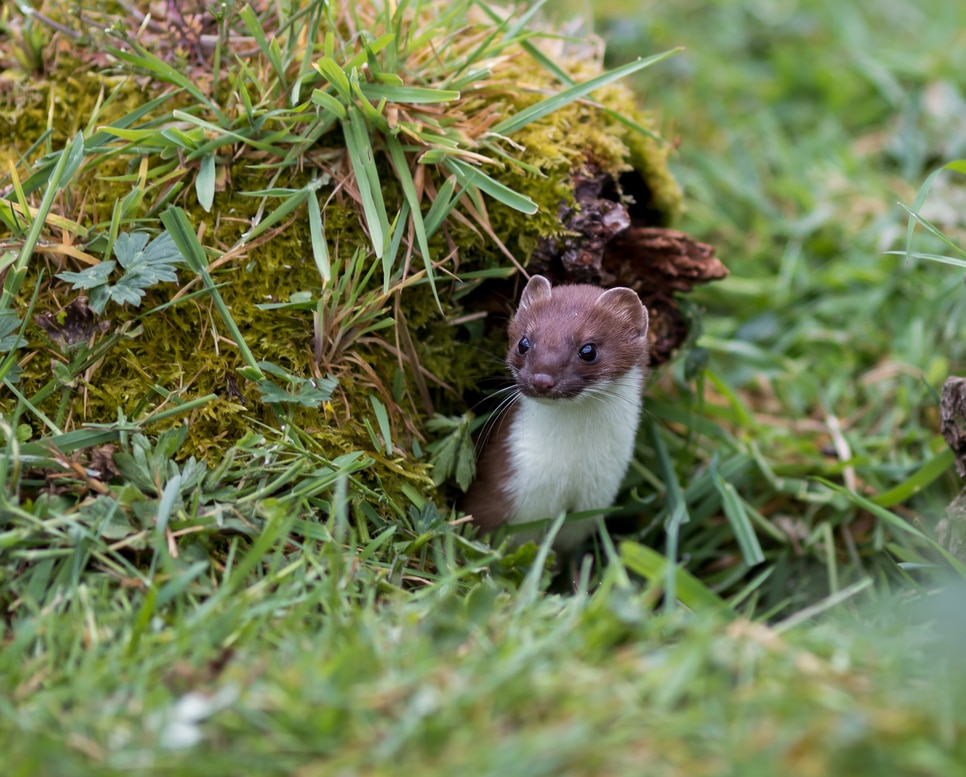Facts about the
Stoat
Scientific name: Mustela erminea
- Can live in most habitats provided there is prey and cover to shelter in.
- The Stoat’s black tail tip may act as a predator-deflection mark.
- For hundreds of years the stoat’s white winter fur (ermine) was sought-after for ceremonial robes.
One of a large worldwide group of around seventy short-legged, long bodied, carnivorous mammals that include Otters, Badgers, Polecats, and Martens, the Stoat or Eurasian Ermine is one of the UK’s most fearless predators. Slightly larger than its close relative the Weasel, Stoats are similarly relentlessly active. Rabbits and Hares are a favoured prey and they will readily tackle animals several times their size, chasing them and pouncing to delivering a powerful bite to the back of the neck.They will also take rodents, readily pursuing mice and voles into their underground burrows. Stoats also climb trees to raid birds’ nests.
Stoats are found throughout the UK and can live in most habitats, provided there is prey to eat and cover to shelter in. They tend to stick to cover and will often use features such as hedgerows and drystone walls to move at high speed around its territory. They tend to avoid spending long in the open, though, where they may be vulnerable to attack from foxes and birds of prey – research strongly suggests that the Stoat’s black tail tip may act as a predator-deflection mark, a ‘distraction’ causing predators to either hesitate long enough for the Stoat to escape or to attack the tail rather than the animal’s head or more vulnerable parts of the body.

Stoats are legally protected in Ireland but, like Weasels, because of the disproportionate influence on wildlife legislation not in the United Kingdom. Gamekeepers and poultry farmers have been trapping and killing Stoats for many years. As records are not required to be kept no-one knows how many, but trapping is less intensive than it used to be and appears to have had little long-term effect on numbers as natural mortality is usually quite high in stoat populations and numbers can quickly recover.
Stoats were also trapped for their furs, especially when ‘in ermine’ – the white colouring that some Stoats (especially in mountainous regions) moult into in winter to make them less conspicuous. For hundreds of years ermine was the most sought-after fur for royalty, court presentations and official portraiture. European monarchs typically used ermine as a projection of power and wealth. From 2019 the late Queen Elizabeth II began to use faux fur, though it’s expected that ceremonial robes made with ermine will still be usable for decades if kept in chilled storage.
Did I see a stoat or a weasel?
Putting aside the old joke about ‘Weasels being ‘weasely’ recognised because Stoats are ‘stoatally’ different’ the clearest way to quickly differentiate between the larger Stoat and its smaller relative is to look at its tail: a Stoat’s tail is proportionately longer (around half the length of its body) and ends in a conspicuous black tip, while a Weasel’s tail is short and stubby and entirely brown. Fur colour is a less reliable indicator: in winter some Stoats (particularly in mountainous areas) may turn white while Weasels are brown all year, but in most regions of the UK they don’t.

